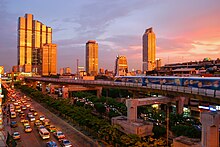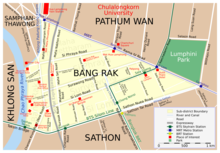Bang rak
| Bang Rak บางรัก |
|
|---|---|
| Data | |
| Province: | Bangkok |
| Surface: | 5.54 km² |
| Residents: | 46,114 (2013) |
| Population density : | 9,121 U / km² |
| ZIP : | 10500, 10501 |
| Geocode : | 1004 |
| map | |

|
|
| Bangkok boroughs | |
Bang Rak ( Thai : บางรัก , [bāːŋ rák] , roughly: "place of love") is one of the 50 districts (Khet) of Bangkok , the capital of Thailand . Bang Rak is in the center of the city and is home to Bangkok's financial district. It includes the main streets Thanon Silom (English Silom Road ) and Thanon Surawong.
geography
Bang Rak is bounded in the north by Rama IV Street (Thanon Phra Ram 4) , in the south by Sathon Street and in the west by Mae Nam Chao Phraya ( Chao Phraya River ) and the Maha Phruetharam Street.
Bang Rak is bordered by four other districts, clockwise from the north: Pathum Wan , Sathon , Khlong San (across the Mae Nam Chao Phraya), and Samphanthawong .
history
Today's Bang Rak district is one of the most historic parts of Bangkok. This is where the port of Bangkok was located until it was relocated to Khlong Toei further downstream in 1947 . The historic customs house on the banks of the Chao Phraya is evidence of this. Foreign trade agencies and immigrant groups settled near the port. To this day, several important embassies sit in Bang Rak, including the Portuguese (the oldest embassy in Bangkok) and the French. As a result, Bang Rak is also one of the districts with the greatest ethnic and religious diversity. This is where the Catholic Mission (including the Assumption Cathedral and the renowned Assumption School ) and the Protestant (Anglican) Mission with the Christ Church Bangkok are located. In addition, Bang Rak is a focus of the Islamic (with a number of mosques) and the Hindu communities of Bangkok (with the Mariamman Temple vulgo Wat Khaek), as well as the ethnic group of Chinese origin .
The district, now known as Bang Rak, pioneered various modern developments in Bangkok: The Bangkok Christian College, founded in 1852, is the oldest private school in Thailand. The Thanon Charoen Krung (laid out 1861–64) was the capital's first paved street, and the first tram line ran on it. The Hotel Oriental , founded in 1876, is the oldest and at the same time one of the most renowned hotels in Bangkok. Field Marshal Chao Phraya Surasakmontri (Soem Saeng-Xuto), who resided in Bang Rak, was the first Siamese to purchase a car in 1897. Founded in the same year on the initiative of British diplomats, BNH Hospital was one of the first modern hospitals in Bangkok.
In administrative terms, the Bang Rak district was established in 1912. The original name of the area was originally in Thai บาง รักษ์ (also pronounced Bang Rak ), which means something like "place of healing", because an important hospital was located here. Over time it became the abbreviated spelling, which now means "place of love". For this reason, Bang Rak is the district that most newlyweds visit, especially on Valentine's Day .
Various important personalities in Thai history lived in Bang Rak, in addition to the aforementioned Chao Phraya Surasakmontri, the former Prime Minister Pridi Phanomyong (1900–1983) and the "father of Thai economics" Puey Ungphakorn (1916–1999). The Bangkok Folk Museum on Soi Charoen Krung 43 provides information about the history of the district.
The population of Bang Rak declined significantly in the 1980s to 2000s; between 1985 and 2011 it almost halved from around 91,000 to just over 46,000, but has been increasing again since then.
Attractions
Bang Rak is known for the area around the Thanon Silom (Thai: ถนน สิ ลม ), which offers many shopping opportunities. Many bars and gogo establishments on nearby Thanon Patpong open late at night . In addition, clothes and souvenirs are sold at the night market. At the Bang Rak market between Thanon Charoen Krung ("New Road") and the banks of the Chao Phraya, you can buy meats in the morning that are rarely available in Thailand, such as mutton and lamb .
The Maha Nakhon at the Chong Nonsi Skytrain station, completed in 2016 and designed by Ole Scheeren , is the tallest building in Bangkok and all of Thailand at 313 meters. Other notable skyscrapers in this district are the State Tower (247 m) with the Lebua Hotel (whose roof bar became internationally known through the movie Hangover 2 ) at the intersection of Thanon Silom and Charoen Krung, the 220-meter-high Jewelry Trade Center and the Wegen its golden tip is a striking 187-meter-high Abdulrahim Place. The Dusit Thani Hotel, with its idiosyncratic triangular shape, is another attraction in the district.
To the west of Bang Rak flows the Chao Phraya, on the banks of which there are several luxury hotels: Hotel Oriental , Shangri-La Hotel and the Royal Orchid Sheraton Hotel. The Oriental was built more than 100 years ago and has been one of the most renowned hotels in the world ever since.
Buddhist temples: There are only a few Buddhist temples ( Wat ) in Bang Rak . To be mentioned here are:
- Wat Hua Lamphong (Thai: วัด หัวลำโพง ) - it takes its name from the Khlong Hua Lamphong, which was filled up long ago and replaced by today's Rama IV Street.
- Wat Maha Phruettharam (Thai: วัด มหาพฤฒาราม วรวิหาร ) - over 300 years old temple on the east bank of the Khlong Phadung Krung Kasem , reconstructed in 1852 during the reign of King Mongkut (Rama IV.) , Since then " royal third class temple ".
Interesting religious buildings of other religions:
- The Hindu Sri Maha Mariamman Temple is also called Wat Phra Sri Maha Umathewi ( วัด พระ ศรี มหา อุ มา เทวี ) or Wat Khaek ( วัด แขก ). It was founded around 1860 by Tamil immigrants. Once a year from the first to the ninth day of the seventh lunar month (late September / early October), the Navaratri festival is celebrated. The statues of the temple gods will be carried by the Hindu community in procession along the Thanon Silom. The temple is also heavily frequented by Buddhists.
- Assumption Cathedral (Assumption Cathedral) of the Archdiocese of Bangkok , which also appears frequently as a location in films.
Educational institutions
The district is home to the main campus of the Catholic Assumption School, founded in 1885, and the private Christian University .
traffic
Bang Rak is connected by both the Skytrain (BTS) and the underground metro . Most of the stops are on the outskirts of the district, however, as the narrow streets do not allow better connections.
Skytrain stations are: Sala Daeng, Chong Nonsi, Surasak and Saphan Taksin (Taksin Bridge, named after King Taksin ).
Metro stations are: Si Lom , Sam Yan and Hua Lamphong.
Ferries connect Bang Rak to the opposite bank of the Chao Phraya River ( Khlong San District ). Speedboats also operate on the river. Several lines go to both the north and south of Bangkok. Your central stop, Sathon , is on the Taksin Bridge (Saphan Taksin) . It is served by all lines. Other moorings in the Bang Rak district include Oriental, Wat Mueang Kae and Sri Phraya.
economy
Bang Rak is part of the central financial and business district of Bangkok. Today, however, the Bangkok Bank is the only major Thai bank that still has its headquarters in this district. The Thanon Silom is the center of the gem and jewelery trade in Bangkok, along the Thanon Charoen Krung there are numerous gold and antique shops.
administration
The district is divided into five sub-districts ( Khwaeng ) :
| No. | Name Khwaeng | Thai | Pop. |
|---|---|---|---|
| 1. | Maha Phruettharam | มหาพฤฒาราม | 12,531 |
| 2. | Si Lom | สีลม | 13,535 |
| 3. | Suriyawong | สุริย วงศ์ | 5,295 |
| 4th | Bang rak | บางรัก | 3,171 |
| 5. | Si Phraya | สี่พระยา | 11,552 |
Individual evidence
- ^ Rajiv Malik: Thailand Hinduism. In: Hinduism Today (Web Edition), July – September 2003.
- ↑ 2013 population statistics ( Thai ) Department of Provincial Administration. Retrieved August 5, 2014.
Web links
- Bang Rak District Office (in Thai)
- Map of Thanon Silom (not to scale.)
- Bangrak Museum - shows the old days with the streets, khlongs and windmills (in English)
Coordinates: 13 ° 44 ' N , 100 ° 31' E





